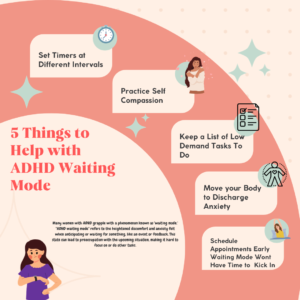5 Things To Do To Help Yourself with ADHD and Waiting Mode

The Struggle with Adhd and Waiting Mode
Many women with ADHD grapple with a phenomenon known as ‘waiting mode.’ “ADHD waiting mode” refers to the heightened discomfort and anxiety individuals with ADHD often feel when anticipating or waiting for something, like an event or feedback. This state can lead to preoccupation with the upcoming situation, making it hard to focus on other tasks.
While many people experience impatience during waiting periods, those with ADHD often feel it more intensely due to their unique brain activity patterns. This state of being can be disruptive, leading to feelings of frustration and self-doubt. Adhd and Waiting mode often manifests as a sense of paralysis, anxiety, and a general feeling of being ‘stuck.’
What are examples of ADHD and Waiting mode in Women?
- Waiting for an Appointment: A woman with ADHD might find it challenging to engage in other tasks before an upcoming 3:00 p.m. doctor’s appointment. She might become preoccupied with the upcoming event, constantly checking the time, feeling restless, anxious, and unable to do anything.
- Waiting for Feedback: After submitting a project at work, the anticipation of feedback can be nerve-wracking. She might constantly check her email, become anxious, ruminate over potential mistakes, and be unable to do anything until she hears back.
- Waiting for Social Events:** The anticipation of a social gathering or date might lead to over-preparation or anxiety. She might change outfits multiple times, worry about the impression she’ll make, or even consider canceling to avoid the stress.
- Waiting for a Response:** After sending a text or leaving a voicemail, the wait for a reply can be filled with repeated phone checking, anxiety, or overthinking the message’s content.
It’s essential to note that while ADHD can cause paralysis or anxiety during waiting periods, everyone’s experience is unique. Not all women with ADHD will respond to waiting in the same way, and many have developed coping strategies to manage these situations.
The Science Behind Adhd and Waiting Mode
Research on adults with ADHD, particularly women, is limited. This is because ADHD was previously thought to impact children primarily. However, we do have some insights from studies on children with ADHD.
Waiting impulsively, a behavior often observed in children with ADHD refers to the struggle to delay gratification or control immediate impulses while waiting for something. It’s characterized by restlessness, fidgeting, and an inability to stay still. Impulsive individuals may constantly check the time, become easily distracted, or express frustration verbally.
In adults, waiting can also provoke anxiety and discomfort. Studies have shown that people with ADHD display distinct brain activity patterns during waiting periods! This heightened brain activity and a dislike for delays and impulsivity might explain why adult women with ADHD find it challenging to engage in other tasks when anticipating an upcoming event.
What Strategies can I use to Combat Adhd and Waiting Mode?
Despite the challenges, there are strategies that can help manage waiting mode. Here are four practical steps you can take:
1. Self-Compassion: Be kind to yourself. Understand that waiting mode is a part of your ADHD and not a personal failing.
2. Low Demand Tasks: Engage in tasks that don’t require a lot of mental effort. This can help you move out of a feeling of stuckness. Keep a list of these handy.
3. Move Your Body: Physical activity can help shift your body out of paralysis and reduce feelings of anxiety. This is especially valuable when waiting for answers or feedback.
4. Schedule Appointments Early: Try to schedule your appointments earlier in the day to avoid being stuck in waiting mode. Allow yourself to stim or fidget or bring other ways to soothe the nervous system that works for you.
5. Set Multiple Alarms: This can help reduce the anxiety about missing your appointment.
Is Waiting Mode Anxiety in Adhd Women?
In women with ADHD, missing an appointment or forgetfulness based on working memory deficits can significantly contribute to the ‘waiting mode’ phenomenon. The anticipation of an upcoming appointment can lead to heightened anxiety and restlessness, often characterized by constant time-checking and a struggle to engage in other tasks. This can also be at the root of waiting mode for many with ADHD, as they have shame attached to past mistakes with managing time due to time blindness.
The Power of Self-Accommodation for Adhd and Waiting Mode in Women
Self-accommodation is a powerful tool for managing ADHD waiting mode. It involves structuring or manipulating your environment to make it as supportive as possible rather than changing you. Scheduling your appointments early in the day is a simple yet effective form of self-accommodation. It’s an easy strategy that can help you avoid waiting mode without the need for complicated interventions.
Wrapping Up Adhd and waiting mode
Understanding and managing waiting mode is a crucial part of living with ADHD. By employing strategies like self-compassion, engaging in low-demand tasks, physical activity, and intelligent scheduling, you can navigate the challenges of waiting mode and lead a more balanced life.
Want to learn more?
Here is another website’s article that’s good.
ADHD and Waiting Mode in Women References
– Hsu, C.-F., Benikos, N., & Sonuga-Barke, E. J. S. (2015). Spontaneous activity in the waiting brain: A marker of impulsive choice in attention-deficit/hyperactivity disorder? *Developmental Cognitive Neuroscience, 12*, 114-122.
– Van Dessel, J., Morsink, S., Oord, S., Lemiere, J., Moerkerke, M., Grandelis, M., Sonuga-Barke, E., & Danckaerts, M. “Waiting impulsivity: A distinctive feature of ADHD neuropsychology?” *Child Neuropsychology*, vol. 25, 2018, https://doi.org/10.1080/09297049.2018.1441819.


